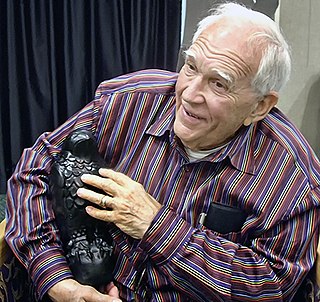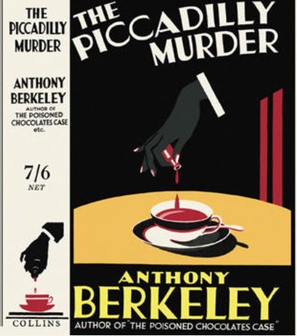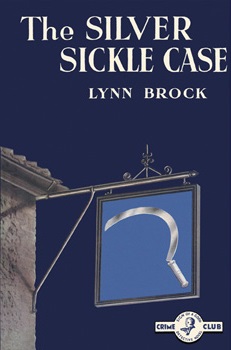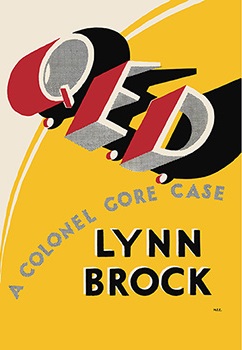
Joseph Nicholas Gores was an American mystery writer. He was known best for his novels and short stories set in San Francisco and featuring the fictional Dan Kearney and Associates private investigation firm specializing in repossessing cars, a thinly veiled escalation of his own experiences as a confidential sleuth and repo man. Gores was also recognized for his novels Hammett, Spade & Archer and his Edgar Award-winning or -nominated works, such as A Time of Predators, 32 Cadillacs and Come Morning.
Inspector Joseph French is a fictional British police detective created by Irish author Freeman Wills Crofts. French was a prominent detective from the Golden Age of Detective Fiction, appearing in twenty-nine novels and a number of short stories between 1924 and 1957. The character was introduced in the 1924 novel Inspector French's Greatest Case, where he investigates a fatal diamond robbery in Hatton Garden. The series relied largely on puzzle mysteries.

Too Soon to Die is a 1953 mystery detective novel by the British writer Henry Wade. It was the sixth in a series of seven novels featuring the character of Inspector Poole, published during the Golden Age of Detective Fiction. It followed a thirteen year gap since the publication of the previous novel Lonely Magdalen.

Dance Without Music is a 1947 thriller novel by the British writer Peter Cheyney. While Cheyney had gained his reputation with series about two celebrated characters Lemmy Caution and Slim Callaghan, he also wrote several popular stand-alone novels about hardboiled private detectives such as this. It was serialised in Britain by The News of the World. In the United States it was published by Dodd Mead in 1948.

The Worm of Death is a 1961 detective novel by the Anglo-Irish writer Cecil Day-Lewis, written under the pen name of Nicholas Blake. It is the fourteenth in a series of novels featuring the private detective Nigel Strangeways.

The Cask is a 1920 detective novel by the Irish-born writer Freeman Wills Crofts. His debut novel, it is considered his masterpiece. Long after the author's reputation had declined, this book was still hailed by critics as a cornerstone of the genre Crofts had been working as a railway engineer before writing the novel, but its success launched him as one of the leading writers of the Golden Age of Detective Fiction. He later went on to create the character of Inspector French of Scotland Yard who appeared in a long-running series of novels.

The Piccadilly Murder is a 1929 mystery detective novel by the British writer Anthony Berkeley. Berkley was a prominent writer during the Golden Age of Detective Fiction, known for his private detective Roger Sheringham series and his development of the inverted detective story. Although not part of the Sheringham series it featured the character of Chief Inspector Moresby of Scotland Yard who also appeared several times with Sheringham. Moresby reappeared with the chief protagonist Chitterwick in a sequel Trial and Error in 1937.
Irish writer Alister McAllister [1877-1943] wrote several plays under the pseudonym Anthony Wharton and later, after moving to England, wrote a series of mystery novels using the pseudonym Lynn Brock.

The Mendip Mystery is a 1929 mystery detective novel by the Irish-born writer Lynn Brock. It was the fifth of seven novels in his series featuring the character of Colonel Wyckham Gore, one of the most prominent investigators during the early stages of the Golden Age of Detective Fiction. It was published in America with the alternative title of Murder at the Inn.

The Deductions of Colonel Gore is a 1924 detective novel by the Irish-born writer Lynn Brock. It was the first in his series of seven novels featuring the character of Colonel Wyckham Gore. Gore enjoyed popularity during the early stages of the Golden Age of Detective Fiction. It was also published under the alternative title The Barrington Mystery.

Colonel Gore’s Second Case is a 1925 detective novel by the Irish writer Lynn Brock. It was the second in his series of seven novels featuring the character of Colonel Wyckham Gore. Gore enjoyed popularity during the early stages of the Golden Age of Detective Fiction. After solving his first case Gore now establishes his own detective agency.

The Kink is a 1927 mystery detective novel by the Irish-born writer Lynn Brock. It was the third novel in his series featuring the character of Colonel Wyckham Gore, one of many investigators active during the Golden Age of Detective Fiction. It is sometimes referred to as Colonel Gore’s Third Case. The novel is noted for being comparatively sexually explicit for the era. Dashiell Hammett wrote a contemporary negative review of the book in The Saturday Review.

The Stoat is a 1940 mystery detective novel by the Irish-born writer Lynn Brock. It was the seventh and last novel in his series featuring the character of the Golden Age detective Colonel Wyckham Gore. It was also his last published work before his death three years later. It marked a return for Gore, who hadn't appeared in a novel since 1930.

The Dagwort Coombe Murder is a 1929 mystery detective novel by the Irish-born writer Lynn Brock. It was the first stand-alone novel by Brock following the success of his Golden age detective Colonel Gore. It was published in the United States with the alternative title The Stoke Silver Case.

The Silver Sickle Case is a 1938 detective novel by the Irish-born writer Lynn Brock. Best known for his Colonel Gore series of mysteries, the novel introduced an alternative detective character Sergeant Venn of Scotland Yard assisted by Detective Constable Kither. It was followed by two sequels.

The Riddle of the Roost is a 1939 mystery detective novel by the Irish-born writer Lynn Brock. It was the third and last in his trilogy featuring the characters of Scotland Yard detective Sergeant Venn and Constable Kither. It was Brock's penultimate novel, followed the next year by The Stoat a final entry into the series of his best-known character Colonel Gore.

The Man Who Was Too Clever is a 1935 mystery detective novel by Anthony Gilbert, the pen name of British writer Lucy Beatrice Malleson. It is the tenth and last in a series of novels featuring her amateur detective and politician Scott Egerton. The following year she introduced a new character, the unscrupulous solicitor Arthur Crook, in Murder by Experts.

Q.E.D. is a 1930 mystery detective novel by the Irish-born writer Lynn Brock. It was the sixth of seven novels in his series featuring the character of Colonel Wyckham Gore, one of the most prominent investigators during the early stages of the Golden Age of Detective Fiction. It was published in the Under States with the alternative title of Murder on the Bridge.

Death at the Helm is a 1941 detective novel by John Rhode, the pen name of the British writer Cecil Street. It is the thirty fourth in his long-running series of novels featuring Lancelot Priestley, a Golden Age armchair detective. It makes reference to earlier stories in the series as the lawyer had defended in court the murderers Priestley had exposed in The Corpse in the Car and Death on the Boat Train. The characters in it were arguably more complexly drawn than in other books by the author.

Nightmare is a 1932 thriller novel by the Irish-born writer Lynn Brock. It is an inverted detective story, and a stand alone work for an author best known for his series featuring the Golden Age detective Colonel Gore.


















